Whale Skeletons
Sperm whale “Echo” skeleton on display in the North Carolina Maritime Museum at Beaufort.
Meet “Echo”
The above video features Bonehenge director Keith Rittmaster when he announced the completed skeletal rearticulation of the deceased, stranded sperm whale, Echo.
There’s a lot to consider when it comes to whale skeletons.
When a whale carcass washes ashore or a whale dies on shore, there are a few things we consider before we rearticulate (or reassemble) the skeleton for display.
We look at:
- The condition of the carcass;
- The location of the carcass;
- Is it a rare species that has limited (or no) representation in public displays?
- Does it have an important conservation or biological lesson to teach.
Rearticulated whale skeletons have tremendous educational and scientific value.
They provide opportunities to study the evolution, comparative anatomy, and bone disorders of these animals.
As you’ll notice in the images below, some whales have obvious and predictable asymmetry in their skulls.
Location, shape, and number of teeth is highly variable between species.
Observers will notice that the flippers have similar bones (humerus, radius, ulna, phalanges arranged in digits) found in other mammals, including humans.
In some skeletal displays we see evidence of injury, disease, healing, and aging.
Skeletal displays also assist in the behavioral interpretations of observations in the wild. For example, a whale’s physical limitations are often not obvious in the wild but an understanding of these limitations through skeletal studies helps us understand the relationships between biology, anatomy, and behavior.
Skull asymmetry is clearly demonstrated in this head-on view of a Cuvier’s beaked whale (Ziphius cavirostris) skull.
Risso’s dolphins (Grampus griseus) typically only have 8 teeth, and they are only in the mandibles (lower jaws). They have no teeth in their upper jaws.
Pectoral fin (flipper) anatomy and teeth only in the lower jaw are shown in this dwarf sperm whale (Kogia sima) skeleton.









